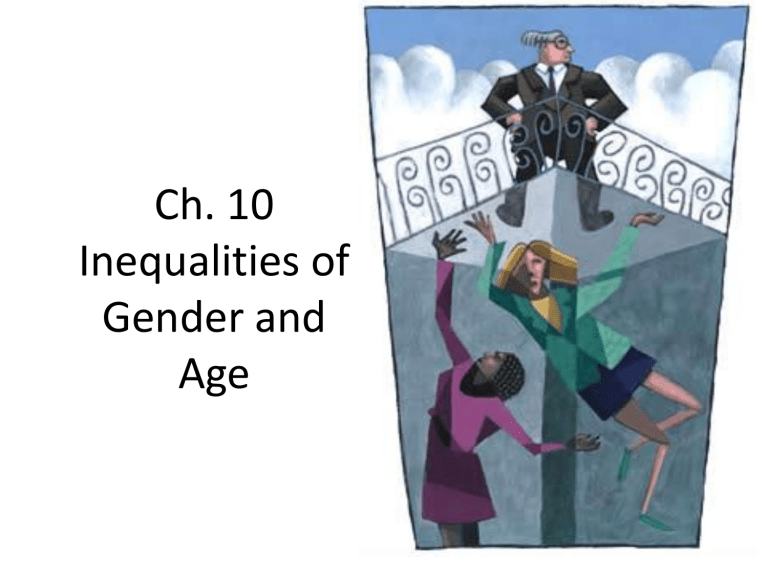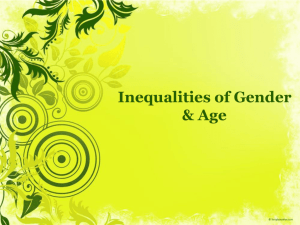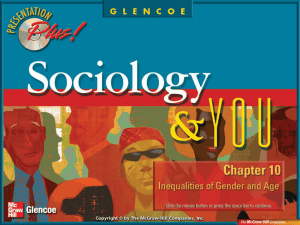Ch. 10 Inequalities of Gender and Age

Ch. 10
Inequalities of
Gender and
Age
Sex and Gender Identity
• Sex – classification of people as male or female based on biological characteristics
• Biological Determinism – principle that behavioral differences are the result of inherited physical characteristics
– This lacks scientific proof
– What few tendencies that are biological are easily overruled by society and culture
• Gender Identity – a sense of being male or female based on learned cultural values
Biology, culture, and behavior
• Research indicates that the brains of men and women are slightly different
• The majority of sociologists argue that gender-related behavior is not primarily the result of biology
• Margaret Mead’s research (1950) on
New Guinean peoples
– The Arapesh – Men and women were raised to be cooperative, unaggressive, and empathetic. Traditional concept of the female gender role
– Mundugumor – Men and women were raised to be aggressive, ruthless, and unresponsive to the needs of others
– Tchambuli – gender roles were opposite of those in Western culture
Theoretical Perspectives on Gender
•
Functionalism and
Gender
– Any pattern of behavior that does not benefit society will become unimportant
• Therefore the division of responsibilities b/w male and female benefited human living
Theoretical Perspectives on Gender
• Conflict Theory and Gender
– It is to the advantage of men to prevent women from gaining access to political, economic, and social resources
• “Gender Apartheid” in Afghanistan
– Conflict theorists see traditional gender roles as outdated
– Women who prefer careers in fields formerly reserved for men have every right to make that choice, whether or not it is “functional” for society
Theoretical Perspectives on Gender
• Symbolic Interactionism and
Gender
– Focuses on how boy and girls learn to act the way they are
“supposed to act”
• Gender socialization – the social process of learning how to act as a boy or girl
– The effect of the media is very powerful
– Parents are vitally important in gender socialization
• Blue or pink clothes
• Trucks vs. dolls
• Mowing the grass vs. doing the dishes
Theoretical Perspectives on Gender
– Schools also aid gender socialization
• Teachers encourage different behaviors
• Clothing styles, school functions, after-school activities
– Peers contribution to gender socialization
• Kids who most closely resemble the traditional roles are typically given the most respect
– Football players, cheerleaders
• Feminine boys and masculine girls are typically assigned low status
Gender Inequality
• Sexism – a set of beliefs, attitudes, norms, and values used to justify sexual inequality
• Occupational and Economic inequality
– In 1999 65% of women worked outside the home compared to
77% of men
– Occupational sex segregation – the concentration of women in lower-status positions
• Ex. – only about 11% of engineer positions are held by women, and about
29% of attorney jobs
• When women are in high-status occupational groups, they are concentrated in lower-prestige, lower-paid jobs
– In 1999 women who worked full-time earned only 72 cents for every dollar earned by men
– In virtually every occupational category, men’s earning power is greater than women’s
– Compared globally U.S. women are closer to the bottom of the equality list than the top
Legal and political Inequality
–
–
– Women are participating in elective politics at an increasing rate
– 1988, Geraldine Ferraro became the 1 st female vicepresidential candidate in the history of the U.S.
– 1996, Madeleine Albright was named the first female
Secretary of State
– Sandra Day O’Connor was appointed the 1 st female
Supreme Court Justice in 1981 by Pres. Reagan
• Age stratification – the unequal distribution of scarce resources based on age
• Ageism – a set of beliefs, attitudes, norm, and values used to justify age-based prejudice and discrimination
• Functionalism and Ageism
– Elderly people in a given society are treated according to the role the aged play in that society
– In many cultures the elderly are treated with great respect and honor
– Attitudes about aging changed greatly as industrialization changed the nature of work
Ageism
Ageism
•
Conflict Theory and Ageism
– Competition over scarce resources is the heart of ageism for the conflict perspective
•
Symbolic Interactionism and
Ageism
– Children learn negative images of older people just as they learn other aspects of culture, through socialization
– Stereotypes of the elderly
• Senile, forgetful, or “daft”
• Sexless
• Incapable of learning new things
Inequality in America’s Elderly
Population
• Sociologists believe that elderly should be viewed as a minority group
• Economics of the Elderly
– The Federal Government assumes that elderly need less money to live
– About 16% of those over the age of 65 are poor
– Most elderly in America do not have sources of income beyond
Social Security
– Poverty rates for minority elderly are high than that of white elderly
• Political Power and the Elderly
– Voting turn out increase w/ age in the U.S.
– Interest groups – a group organized to influence political decision making
• AARP





